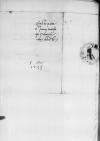Letter #945
Bona Sforza to Ioannes DANTISCUSCracow (Kraków), 1533-05-05
Manuscript sources:
Prints:
| ||||||
Text & apparatus & commentary Plain text Text & commentary Text & apparatus
Reverendo in paper damaged⌈[Reverendo in]Reverendo in paper damaged⌉ Christo Patri, domin paper damaged⌈[domin]domin paper damaged⌉o
Reverende in Christo Pater, sincere nobis dilecte.
Cum proficisceretur istuc in
Datum
Ad mandatum sacrae maiestatis reginalis proprium


 BCz, 1601, p. 638
BCz, 1601, p. 638